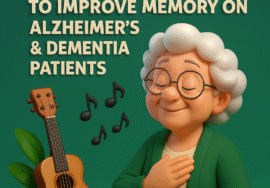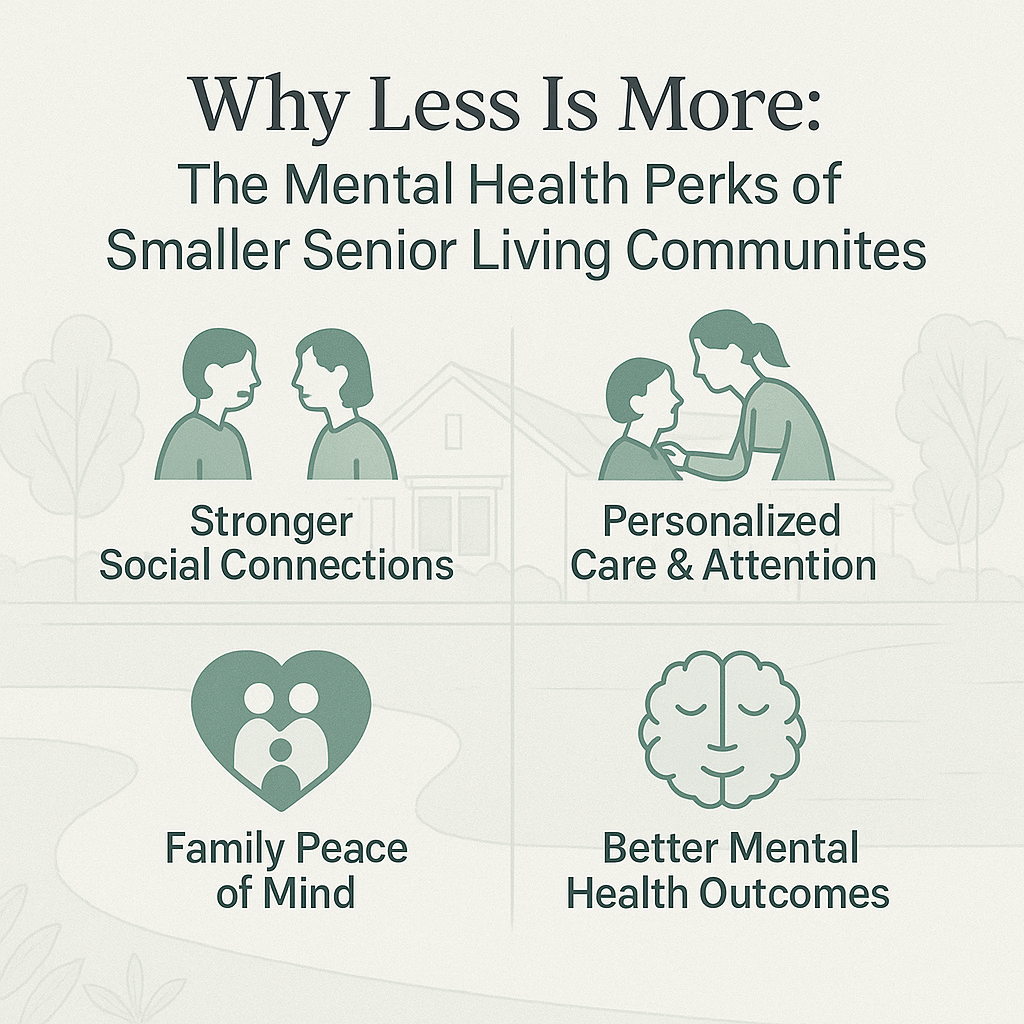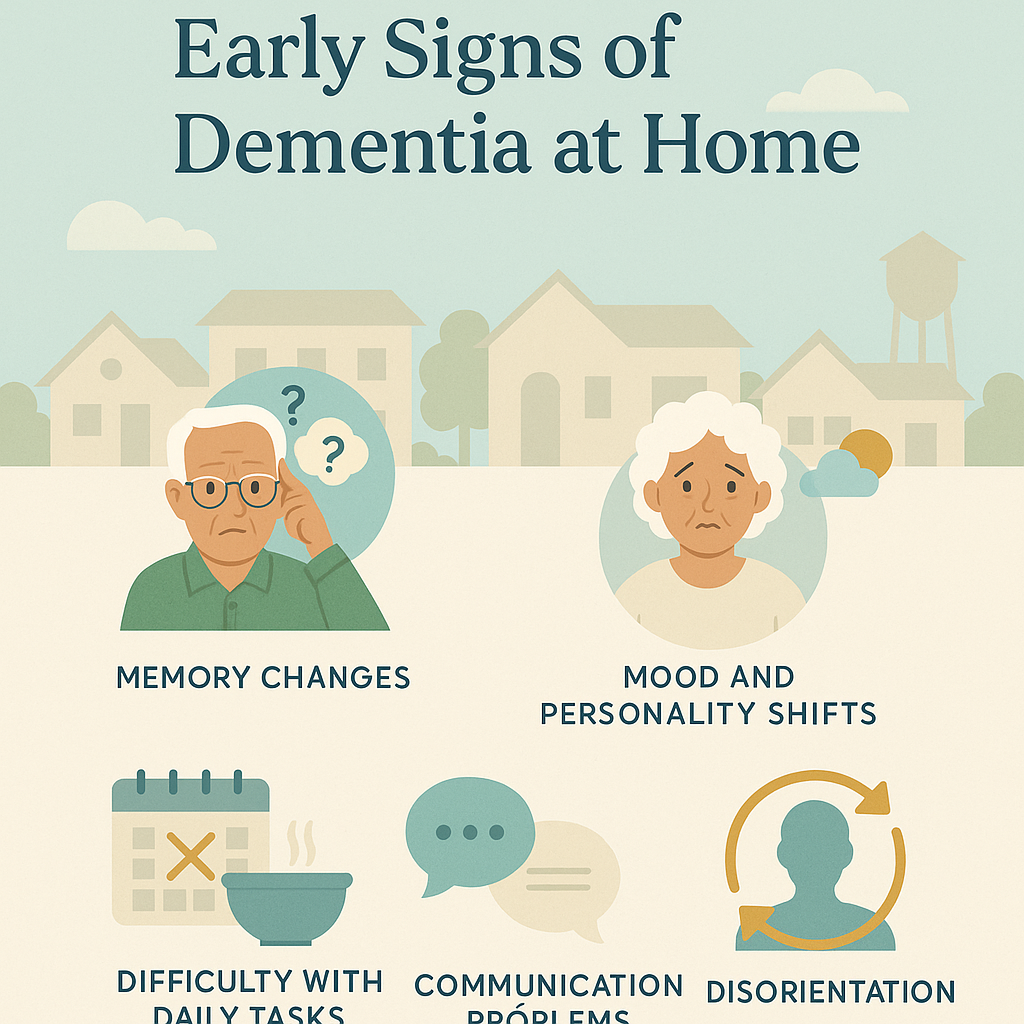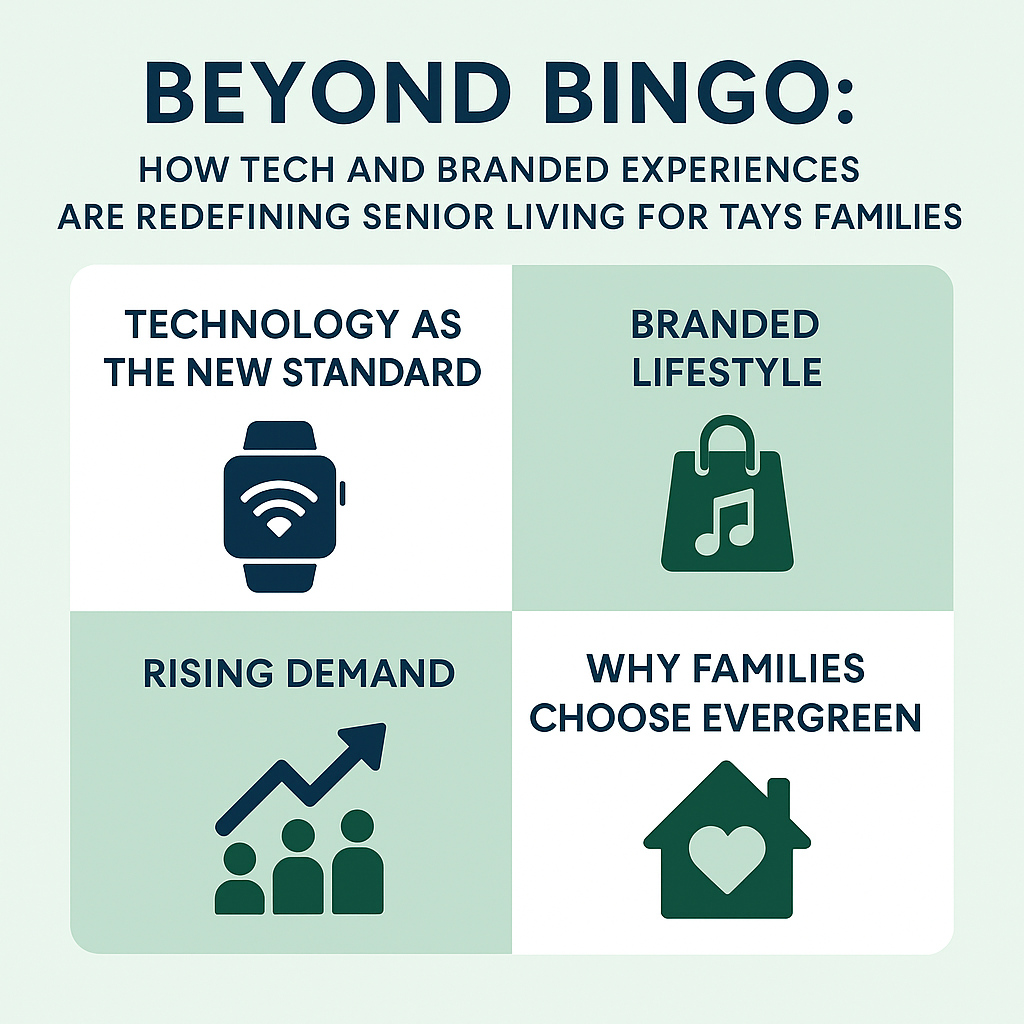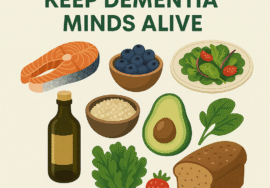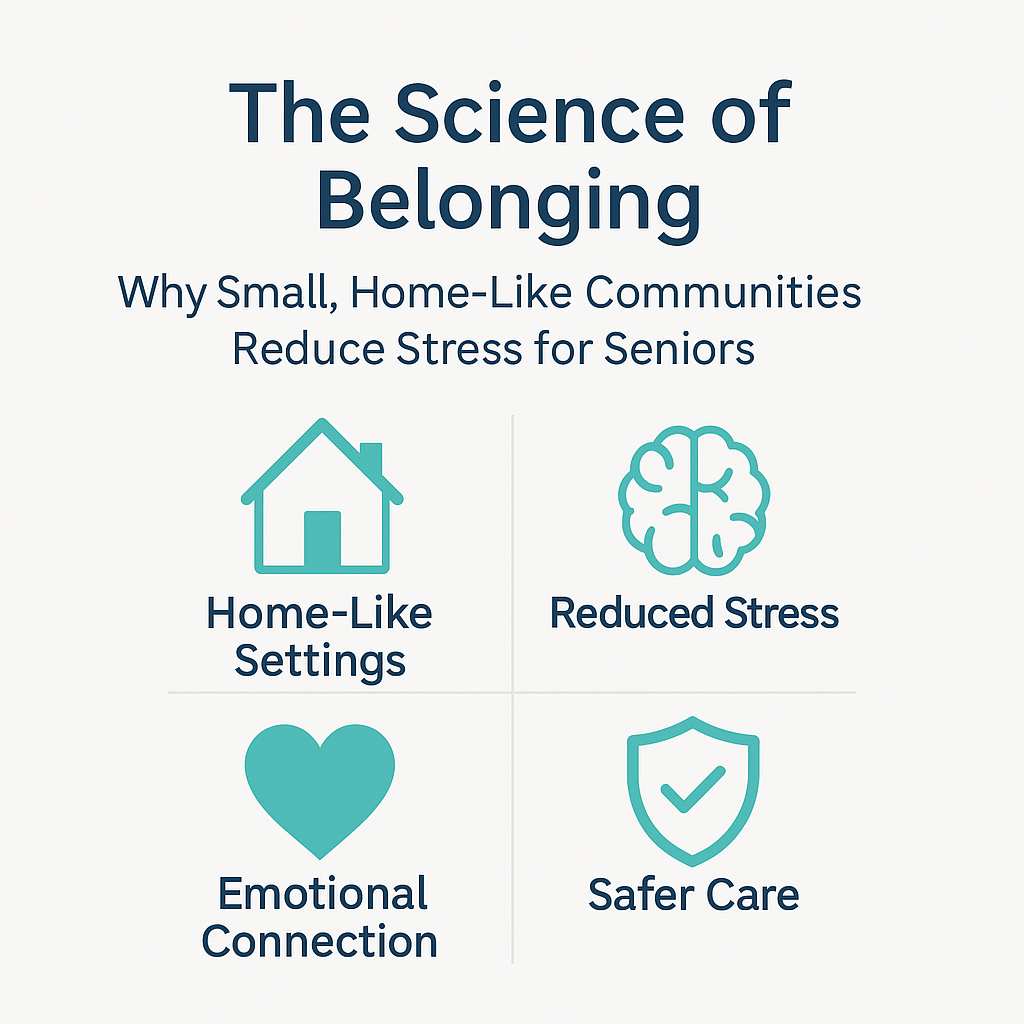
The Science of Belonging: Why Small, Home-Like Communities Reduce Stress for Seniors
Table of Contents
- The Psychology of Belonging and Aging
- How Stress Affects Seniors Physically and Emotionally
- The Role of Environment in Reducing Anxiety
- Why Small, Home-Like Communities Offer Unique Advantages
- The Family Perspective: Peace of Mind and Connection
- Real-World Examples of Belonging in Action
- Frequently Asked Questions About Belonging and Senior Living
The Psychology of Belonging and Aging
Human beings are wired for connection. Belonging is not a luxury or an optional comfort—it is a biological need that shapes our mental and physical health. As people age, the importance of belonging intensifies. Seniors often face a narrowing of social circles due to retirement, relocation, or the passing of loved ones. When belonging is disrupted, loneliness and stress can quickly take root.
Research from leading gerontology studies shows that seniors who feel connected experience lower rates of depression, fewer hospitalizations, and even longer lifespans. Belonging acts as a protective layer against stress, supporting resilience during times of change. In contrast, environments that feel isolating or institutional can strip away this sense of identity and security.
This is where the size and structure of a community become critical. Large, crowded facilities often mimic the feel of hospitals or corporate settings. The environment can unintentionally heighten stress by overwhelming residents with unfamiliar faces, noisy hallways, and a lack of personal attention. Seniors may retreat inward, feeling invisible in a sea of strangers.
Small, home-like communities shift that dynamic completely. Instead of hundreds of residents spread across massive dining halls and activity calendars, these communities intentionally keep numbers low. Every person is known by name, routines are personal, and the atmosphere reflects the intimacy of a household rather than the scale of an institution.
For families searching for assisted living in Katy TX, this distinction matters more than they realize. The right environment can help a parent thrive rather than merely “settle.” The science of belonging explains why smaller settings do more than offer convenience, they actively reduce stress, promote dignity, and rebuild the emotional foundation that aging too often erodes.
How Stress Affects Seniors Physically and Emotionally
Stress is often underestimated in older adults. Families may assume their parents are “just slowing down” when in reality, chronic stress is silently damaging both body and mind. Understanding this impact is critical when evaluating senior living options.
Biologically, stress triggers the release of cortisol, the hormone designed to prepare the body for fight-or-flight. In moderation, cortisol helps people adapt. In seniors, however, prolonged exposure can be devastating. Elevated cortisol has been linked to:
- Weakened immune systems – making seniors more vulnerable to infections and slower to recover.
- Memory decline and confusion – worsening the symptoms of dementia and Alzheimer’s disease.
- Poor sleep patterns – further compounding fatigue, irritability, and anxiety.
- Increased blood pressure and heart strain – raising risks of stroke or cardiac events.
- Digestive issues and weight loss – eroding physical strength and stability.
On the emotional side, stress manifests in ways families often misinterpret. Irritability, withdrawal from activities, or repeated health complaints may not be “normal aging” at all—they are frequently stress responses to feeling unsafe, unseen, or out of place.
Large, institutional-style facilities unintentionally heighten this stress. Imagine a parent navigating long hallways, encountering staff who rotate too often to remember their preferences, or trying to sleep in a noisy environment. Even small frustrations compound into a daily baseline of anxiety. Over time, stress erodes independence and quality of life.
In contrast, seniors living in smaller, home-like communities experience a calming counterbalance. Instead of constant overstimulation, the environment fosters familiarity. They recognize the staff, know their neighbors, and can navigate spaces without confusion. Stress responses diminish because the environment signals safety rather than threat.
For families researching memory care in Katy TX, this is especially relevant. Stress accelerates cognitive decline in dementia patients, and environments that reduce it can help preserve abilities longer. Choosing the right setting isn’t simply about amenities—it’s about protecting a loved one from the invisible, corrosive effects of chronic stress.
Belonging, when woven into daily life, acts as a buffer against these harms. It reminds seniors they are part of a family-like unit, not just a number in a system. And for adult children, it reframes the choice: the right community doesn’t just provide care, it creates the conditions where stress gives way to peace.
The Role of Environment in Reducing Anxiety
Environment is more than walls, furniture, and décor—it’s a living ecosystem that either amplifies stress or dissolves it. For seniors, especially those facing cognitive decline or chronic health challenges, the setting where they live plays a defining role in their overall well-being.
Researchers in environmental psychology consistently demonstrate that human surroundings influence everything from mood to memory retention. Lighting, noise, color schemes, and even room layouts can regulate stress levels. When seniors live in environments designed for efficiency rather than intimacy, their bodies often respond with tension, confusion, and fatigue.
Consider the difference between two dining experiences: one in a large cafeteria filled with dozens of tables, clattering dishes, and rotating staff; the other in a small, sunlit kitchen where a familiar caregiver serves food in a predictable routine. The first scenario can create anxiety and sensory overload, while the second fosters comfort and familiarity. The difference may seem small, but over weeks and months, it shapes physical health and emotional stability.
Noise is another powerful factor. Seniors with dementia often struggle with auditory processing, and constant background noise can lead to agitation or withdrawal. In smaller, home-like communities, noise levels are naturally lower, allowing residents to focus on conversation, meals, or quiet reflection. This seemingly simple shift can reduce anxiety levels significantly.
Lighting plays an equally important role. Harsh fluorescent bulbs commonly found in large facilities disrupt circadian rhythms, making sleep patterns unpredictable and worsening confusion. By contrast, natural light and warm-toned bulbs used in smaller settings signal safety and balance. Residents often sleep better, experience more stable moods, and engage more readily in activities.
Even furniture placement influences anxiety. In oversized facilities, long hallways and repetitive layouts can be disorienting. In smaller homes, common spaces mirror the flow of an ordinary household—living rooms, kitchens, and porches designed for gathering. This spatial familiarity helps seniors relax, reducing the cognitive load of navigating an unfamiliar building.
For families exploring assisted living Katy TX, these environmental factors should not be overlooked. The right environment doesn’t just provide a roof and meals—it actively works to reduce anxiety and restore peace of mind. In a small, home-like community, stressors are minimized, and the environment itself becomes part of the caregiving team.
Belonging is not only built through people; it is reinforced every time the environment whispers: you are safe, you are home, you belong here.
Why Small, Home-Like Communities Offer Unique Advantages
When families first begin searching for senior living options, the focus often falls on amenities, price points, or the size of the facility. What many don’t realize is that the scale of the community itself profoundly shapes a loved one’s quality of life. Small, home-like communities are not just a trend—they are a direct response to what science shows seniors need most: belonging, stability, and reduced stress.
In large, traditional facilities, residents may be one of hundreds. Staff rotate across multiple wings, and even the most compassionate caregivers may not have time to learn every resident’s personal routines. A parent might feel overlooked, not out of neglect, but because the system is simply too big to allow intimacy. Stress builds because residents are continually reminded that they are part of an institution, not a family.
By contrast, in smaller communities like Evergreen Cottages, the environment is intentionally intimate. Each resident becomes part of a household where caregivers are consistent and relationships develop naturally. Familiar faces greet them each day. Caregivers know not only medical histories but personal quirks, favorite foods, and comfort routines. This recognition is powerful—it affirms identity and creates the sense of home that dissolves stress.
Small settings also allow for flexible routines. In a large facility, schedules must be standardized to manage hundreds of residents. Meals, activities, and medication times become rigid. Seniors who thrive on choice may feel stripped of independence. In a home-like environment, the rhythm of life is more adaptable. Residents can eat when they’re hungry, nap when they’re tired, and engage in activities that feel meaningful rather than mandatory.
Safety is another key advantage. Smaller communities are easier to navigate, reducing fall risks and disorientation. Staff-to-resident ratios are higher, meaning more attentive care. For families considering memory care Katy TX, this is particularly important—residents with dementia require environments where wandering risks are minimized and staff can respond quickly to subtle changes in behavior.
Perhaps the greatest advantage, though, is the restoration of dignity. Seniors often fear losing control over their lives, and large institutional environments can reinforce that fear. Small, home-like communities flip the narrative. They provide care without stripping away identity, creating spaces where residents are known, valued, and deeply connected.
For adult children struggling with guilt over moving a parent into assisted living, this distinction matters. Choosing a smaller, home-like community means you are not “putting Mom in a facility”—you are giving her a home where she belongs, surrounded by people who see her as family. That difference reduces stress not only for residents but also for the families who love them.
The Family Perspective: Peace of Mind and Connection
Belonging is not only a resident experience—it’s a family experience. Adult children often carry invisible stress long before their parent ever enters senior living. Questions like Will they be safe? Will they feel lonely? Did I make the right choice? weigh heavily. These worries can cause sleepless nights, tension with siblings, and even hesitation to make a decision at all.
Small, home-like communities ease that burden by providing reassurance. Families can walk into Evergreen Cottages and immediately see the difference: residents engaged in conversation at a kitchen table, caregivers laughing with someone they clearly know well, and a calm atmosphere that feels closer to a household than a facility. This environment doesn’t just lower stress for seniors—it allows adult children to exhale.
In larger, institutional settings, family visits can feel transactional. You check on your parent, talk briefly with staff, and leave still wondering whether your loved one is truly known. In smaller settings, visits often feel like joining a family gathering. You see firsthand the connections forming, the attention given, and the ways your parent is treated with dignity. That experience changes how families talk about senior living—it becomes less about “placement” and more about belonging.
For those comparing assisted living in Katy TX, this perspective is essential. Belonging does not appear on a price sheet, but it is the hidden value that transforms quality of life for both seniors and their families. Choosing a home-like environment is not simply a care decision—it’s a choice to reduce stress at every level, from resident to caregiver to family member.
Frequently Asked Questions About Belonging and Senior Living
What is the difference between a small, home-like senior community and a large facility?
Small communities prioritize intimacy and familiarity. They typically have fewer residents, higher staff-to-resident ratios, and environments designed to feel like a home rather than an institution. Large facilities often operate with more rigid schedules and less personal interaction.
How does a smaller community reduce stress for seniors?
Seniors experience less overstimulation, recognize familiar caregivers daily, and live in environments designed for comfort. These factors lower anxiety, improve sleep, and create stronger emotional connections.
Is memory care better in a smaller community?
Yes. For families seeking memory care in Katy TX, small environments are especially beneficial. Residents with dementia thrive in spaces with less noise, fewer confusing hallways, and consistent caregivers who know their patterns and needs.
Does belonging really impact physical health?
Absolutely. Research shows that seniors who feel connected have lower rates of depression, fewer hospital visits, and even longer lifespans. Belonging reduces stress hormones, which protects both the brain and the body.
How do I know if my parent will feel like they belong?
Visit the community. Pay attention to whether staff greet residents by name, whether spaces feel calm and familiar, and whether your parent seems comfortable. Belonging is felt, not marketed—it shows in daily interactions.
Are smaller senior living communities more expensive?
Not always. Pricing varies, but families often find that the value of personal care, reduced stress, and higher quality of life outweighs small differences in cost. Many communities also offer transparent pricing for assisted living in Texas.
What questions should I ask when touring a senior community?
Ask about staff-to-resident ratios, consistency of caregivers, flexibility in routines, and how the environment supports stress reduction. For memory care, ask how they manage noise, lighting, and resident engagement.
How does Evergreen Cottages compare to larger assisted living facilities?
Evergreen Cottages was intentionally designed as a small, home-like community. Each resident is part of a household, staff are consistent and attentive, and the environment is built to reduce stress. Families in Katy TX choose Evergreen because it offers both professional care and the comfort of belonging.
What if my parent resists moving into senior living?
This is common. Seniors may fear losing independence or worry about being “put away.” Framing the move as joining a small, family-like household rather than a facility can ease this fear. Visiting in person often helps them see the difference.
Why is belonging important for families too?
When families know their loved one is safe, seen, and truly connected, their own stress levels drop. Belonging creates peace of mind not only for residents but for the adult children making these decisions.


